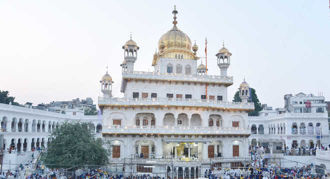
A resident of Baserke village points to low water level in the minor on Saturday. tribune photo: Vishal Kumar
The Tribune deep dive into canal irrigation system in state Part-III
Manmeet Singh Gill
Tribune News Service
Tarn Taran, June 29
Scrolling on his mobile while sitting under the shade of a neem tree near his tubewell, Balkar Singh is anxiously waiting for power supply to run the tubewell for irrigating his paddy fields in Bhalo Patti village.
It is ironic that a water-channel from Baserke Rajbaha, the canal minor from Buchar to Bhalo Patti — one of the several channels of the Upper Bari Doab Canal (UBDC) which brings water from the Ravi river — is just across the 8-ft wide unpaved road. But either it runs dry or the water level and speed are insufficient for irrigation.
The village is not just geographically the last village in the district on the Indian side with the international border with Pakistan, but seems last on the mind of the government also.
“This low quantity of water — just in trickles — you are seeing in the canal minor now, has come after a decade and a half. And maybe, it won’t be after a few days or a week later,” Balkar, about 50, said in a matter-of-fact tone.
Low level renders water useless
Though after government intervention this year the water in this channel has reached its ‘tail’ but due to low level, it is of no use. In fact, it has reached this far because most of the farmers are not using it as they continue to draw water from tubewells. —Chamkaur Singh, Farm labourer
Inderpreet Singh of Baserke village said, “Our canal minor has a sanctioned strength of nearly 287 cusecs but the present discharge in it is merely of 150 to 175 cusecs.” Singh said. He pointed out the canal syphon built near his village was leaking due to poor maintenance. “Lot of water, which ideally should go to the fields, is leaking from the drain below and flowing towards Pakistan,” he rued.
A drive on the 20 km ‘kuccha’ road alongside the canal minor reveals that Balkar is not an exception. There are over a hundred tubewells like his, in close proximity to the water channel in Punjab, also known as a land of five rivers. It paints an ironic picture that despite the channels, the tubewells have to be operated, worsening the already depleted underground water. There are 79,409 tubewells in Tarn Taran district alone.
Though after government intervention this year, the water in this channel has reached its ‘tail’ but due to low level, it is of no use. “Actually, it has reached this far because most of the farmers are not using it as they continue to pump the tubewells,” said Chamkaur Singh, a farm labourer working in the farthest fields alongside the border.
“Why wouldn’t we use this water which comes down from the hills and has more nutrients,” he asked.
So long has been the wait that most of the farmers have demolished the ‘khaal’ (irrigation channel) in their fields. “With no water running, the ‘khaals’ had become a home for snakes and rats,” said another farmer Sukhchain Singh. Farmers demolish the channels and use the additional land to sow crops.
The absence of canal water for irrigation has also caused havoc to the groundwater table. Even the farmers are forced to go for deeper and deeper borewells to draw water.
A section of the farmers feels that free power for tubewells coupled with the decision to waive water cess had proven fatal for the canal irrigation system. “While the first made the farmers lethargic, the second left the government with no money to care for the upkeep of the canal system,” summed up Parshotam Singh, another farmer.
However recently, especially in the past year, efforts have been made for relining of defunct minors and reviving ‘khaals’.
A veteran farmer leader, Rattan Singh Randhawa, said, “The UBDC has a sanctioned strength of 9,000 cusecs. But due to its poor network, it is merely drawing half of this amount. We have been demanding remodelling of the canal and increase in sanctioned strength to 12,000 cusecs to meet the need of the agricultural sector.”
Canal built by Shah Jahan
Baserke Rajbaha (canal minor) is part of the Upper Bari Doab Canal (UBDC) with seven branch canals, 247 distributaries and a huge network of minors. Spread over a length of 3,119 km, the UBDC network has a capacity to irrigate 5.73 lakh hectares. The canal was first built by Emperor Shah Jahan in 1693 for carrying water of the Ravi from Madhopur to Lahore. Improvements in the canals were made by Maharaja Ranjit Singh and an Amritsar branch was constructed.
Distributary running at 110% capacity: Water Dept
Responding to the news report ‘Tail-end farmers grapple with severe water shortage’ published on June 29 in these columns, the Water Resources Department denied the claims. It said Panjawa distributary had been running continuously since April 2024 on “110 per cent to 114 per cent capacity” to irrigate command area and was closed on weekly rotational basis from June 22 to 28. As a long-term measure to improve irrigation facility in the area, the present government took the decision to construct another canal — Malwa Canal — parallel to the twin canals — Rajasthan Feeder and Sirhind Feeder — which will irrigate the area now under lift pumps. Hence, more water would be available for Abohar area from Sirhind Feeder, it said.
Join Whatsapp Channel of The Tribune for latest updates.


























